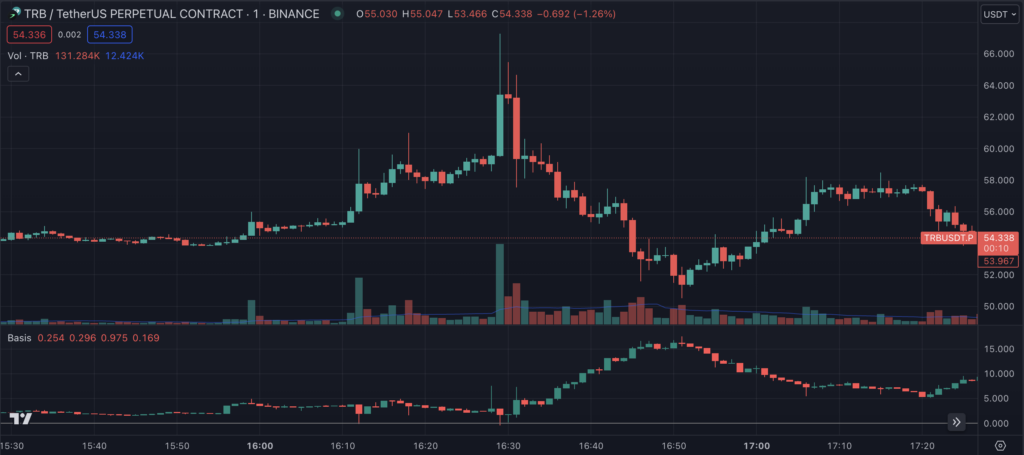Directional Trading with Basis
Know that when the price of an altcoin rises significantly OR there is a large amount of volatility: basis tends to rise as a result. Let’s take a look at our first basis chart.
The top portion of the chart shows the futures’ price of the asset and the bottom portion of the chart shows basis. The y-axis of Basis represents the percentage amount that the spot is higher than the perpetual asset. As you can see from the price action: basis steadily rose due to the surge in volume and volatility from around 1% up to 16%. Let’s run through an example of the PNL you would have had on this play if you had entered at the timestamp of 16:30 and exited at the timestamp of 16:50.
The entry: You have a 10000 USDT account with 8000 USDT in spot and 2000 USDT in your perpetual wallet. You entered long at a basis of 1% when you bought spot at 63.63 by buying 125 TRB and you shorted the perp at 63 by shorting 125 TRB. Both positions are worth around 8000 USDT. Remember that during a basis trade: you need to keep the coin size the same on both trades — not the notional USDT value the same.
You did so due to the fact that the coin had just experienced significant volatility as the perp price rose rapidly in 1 minute from 59.5 up to 67 and as a smart basis trader, you know that basis is very likely to expand.
The exit: You see that basis has just increased to 16% and you decide to take profit. You close your short position with by buying at a price of 52 on the perp and selling your long position on spot at a price of 60.32. You make 1375 in profit from your perp position and lose 413.75 from your spot position giving you a closed basis profit of 961.25 before fees. You pay 3 dollars in fees (0.02% per order) for shorting and buying on the perp position and pay 7.75 in fees on your spot position (0.05% per order) giving you a final profit of 950.5 USDT.
Steps
- Identify the most volatile altcoins in the last 24h period, or coins that you believe will be very volatile (coins you would preferable be bullish on as well)
- Check their liquidity by looking at the order book for its spot and perp pairs (a 1 tick bid-ask difference is best)
- If the liquidity is good, use a 80-20 split with your capital (80% of capital used to buy spot and 20% to use in your futures wallet as margin for the perp position) and make sure to enter with the same contract size long spot and short perp
- Record your basis entry percentage, do this by using the calculation of ((average entry spot price – average entry perp price)/(average entry spot price/2 + average entry perp price/2))*100
- Exit the basis trade either partially or in full, preferably when the basis becomes quite positive and funding is negative (refer to the execution section for entry/exit strategy)

